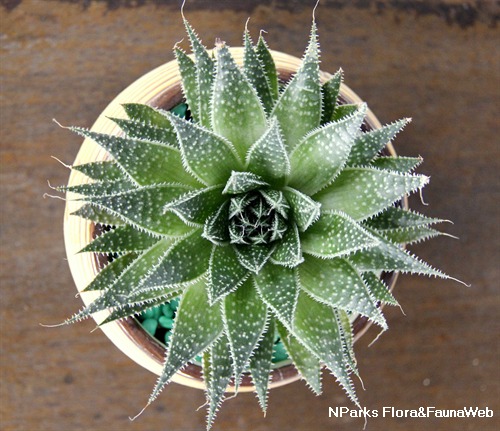
Name
Classifications and Characteristics
| Plant Growth Form | Succulent Plant, Herbaceous Plant |
|---|
Biogeography
| Native Distribution | South Africa |
|---|---|
| Native Habitat | Terrestrial |
Description and Ethnobotany
| Growth Form | Small, clump forming succulent with individual rosettes 12-15cm across in diameter |
|---|---|
| Foliage | Leaves dark green, 6-8 cm long by 2cm wide, with white turbercles on both the upper and undersurface of the leaves. Edges of leaves with a row of soft spines; tips of leaves drawn out into a long, soft bristle. |
| Flowers | Inflorescence to 30cm long. Flowers tubular,2.5-3.5cm long, orange - orange red, greyish green at the tips of the petals. |
| Associated Flora | In Singapore, the flowers are visited by the Olive backed Sunbird for nectar |
| Etymology | The specific epithet 'aristata' refers to the lace like, soft bristle that is found on the tip of its leaves |
Landscaping Features
| Desirable Plant Features | Ornamental Flowers, Ornamental Foliage, Ornamental Form |
|---|---|
| Landscape Uses | Interiorscape/ Indoor Plant, Container Planting |
| Thematic Landscaping | Rockery / Desert Garden |
Fauna, Pollination and Dispersal
| Fauna Pollination Dispersal Associated Fauna | Bird-Attracting |
|---|---|
| Pollination Method(s) | Biotic (Fauna) |
| Seed or Spore Dispersal | Abiotic |
Plant Care and Propagation
| Light Preference | Semi-Shade, [Remarks] (This species can be grown indoors as long in very bright filtered light, and grows best in areas with exposure to morning sun. ) |
|---|---|
| Water Preference | Little Water, [Remarks] (Do not over water or allow the plant to sit in a wet or soggy media as this can cause it to rot. Always allow the planting media to dry out between waterings. ) |
| Rootzone Tolerance | Well-Drained Soils, Low Humidity / Aircon, Disease / Pest Resistant, Easy to Grow |
| Planting Remarks | Use a coarse, well drained planting mix for this species |
| Maintenance Requirements | Low |
| Fertilizing | Feed regularly using dilute liquid fertilizer or by incorporating slow release fertilizer pellets into the potting mix |
| Pest(s) | Sucking Insects |
| Propagation Method | Seed, Division |
Foliar
| Foliage Retention | Evergreen |
|---|---|
| Mature Foliage Colour(s) | Green, White |
| Mature Foliage Texture(s) | Thick |
Floral (Angiosperm)
| Flower Colour(s) | Orange, Red |
|---|---|
| Flower Texture(s) | Powdery / Waxy Bloom |
Image Repository
Others
| Master ID | 32242 |
|---|---|
| Species ID | 6650 |
| Flora Disclaimer | The information in this website has been compiled from reliable sources, such as reference works on medicinal plants. It is not a substitute for medical advice or treatment and NParks does not purport to provide any medical advice. Readers should always consult his/her physician before using or consuming a plant for medicinal purposes. |


